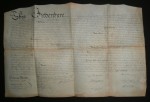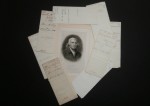Morris letter to Richard Varick, Esq. asking for how a change of officers in Mayor’s Court can be handled.
Note: Dutch Paper Watermark: “Honic & Zooman” (O-1)
Other Interesting Morris Documents
Sale of Asylum Company land from John Nicholson. (O-2)
 Deed notarized outlining the conveyance of Standish Forde to Andrew Summers. 38 acres. Forde and Joseph Ball received property on Dec. 11, 1797 from a foreclosed mortgage of Robert Morris. This is the deed for property that was Robert Morris’ residence when he went to jail. Signed by S. Forde. (O-3)
Deed notarized outlining the conveyance of Standish Forde to Andrew Summers. 38 acres. Forde and Joseph Ball received property on Dec. 11, 1797 from a foreclosed mortgage of Robert Morris. This is the deed for property that was Robert Morris’ residence when he went to jail. Signed by S. Forde. (O-3)
Sale of Stock Certificate in Asylum Company. (O-4)
Letter from Morris to son Thomas. Suggests that his son helps Thomas O’Connor to purchase land in Genesee Country. (Morris is now out of prison and offering real estate advice to his son Thomas, an attorney.) (O-6)
 Deed for a city lot in Philadelphia at King and Race Streets near the Delaware River. Signed twice by James Greenleaf and his wife Ann. Also signed by John Lawrence, member of the Continental Congress and was the first representative of Congress from New York City. Also signed by William Tilghman and Edward Tilghman. (O-7)
Deed for a city lot in Philadelphia at King and Race Streets near the Delaware River. Signed twice by James Greenleaf and his wife Ann. Also signed by John Lawrence, member of the Continental Congress and was the first representative of Congress from New York City. Also signed by William Tilghman and Edward Tilghman. (O-7)
Robert Morris dies on 12th Street in Philadelphia and buried in Christ’s Church.
Lease from Charles Chauncey to Michael Baker. The land is on the west side of 5th Street between Sassafras and Cherry, next the Presbyterian Burial Ground. Robert Morris owned the property in 1777. (O-9)
Lease to from John Baker, Abraham Kintzing and Richard Rush to Michael Baker for the estate Isaac Hazlehurst. The land is on the west side of 5th Street between Sassafras and Cherry, next the Presbyterian Burial Ground. Morris sold the property in 1776. Richard Rush was the Secretary of Treasury from 1825-1828. (O-10)
Three deeds presumed to relate to “Morris Folly,” the land on which Morris was to build his dream palace on the South side of Chestnut between 7th and 8th Streets in Philadelphia.
Various portraits of Robert Morris. (O-16)






